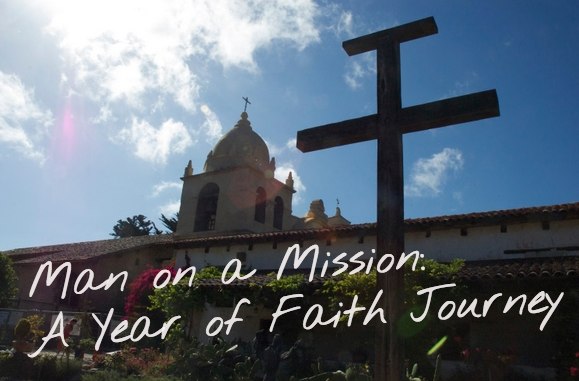Editor’s note: Today, we continue our special series with Kirk Whitney – “Man on a Mission” will take all of us along on Kirk and Debbie Whitney’s pilgrimages to view and pray at the California Missions. I thank Kirk personally for this amazing opportunity to share these treasures with our readers! LMH
We are headed from our home in central California to the first stop on the final leg of our California Missions tour. Common sense and Google maps would both suggest that we take Highway 99 through the central valley,merge on to Interstate five, drop into the Los Angeles basin, then work our way south via the San Gabriel Valley.
We were in no mood for common sense or strict timetables on that particular Friday. We opted to take a more leisurely route, turning left at Bakersfield and climbing the Tehachapi grade. This added 20 minutes or so to our drive, but gave us the opportunity to bypass the LA freeways and bisect the Mojave Desert. (It also gave us a chance to have lunch at one of our favorite bakeries in downtown Tehachapi.)
The drive through the desert on the way to Oceanside was a great way to get in the mood for a mission visit. There are long stretches of road between Mojave and Barstow where there is little to see other than tumbleweed and Joshua trees. One hundred feet or so beyond the highway, the land looks as it easily could have at the time the missions were founded.
[gallery link="file" ids="51769,51770,51771,51772,51773,51774"]
We arrived at Mission San Luis Rey by mid afternoon. San Luis Rey's facade is unique among the missions. Its white walls and blue domed bell tower hint of Moorish Spain more than Alta California.
The mission grounds are spacious and feature some beautiful garden spaces. The front archway is lined with several huge crimson bougainvillea, the courtyards are host to a variety of roses, cacti and feature a several large pepper trees, one of which is regarded to be the first pepper tree planted in California.
San Luis Rey is not run by the local diocese nor is it a State Park. It is administered by a small group of Franciscans. They fund the operation and restoration of the Mission through public admission fees, income from their on-site retreat center, private donations and grants.
Although they appear to struggle with resources, their efforts to maintain and restore the Mission have yielded spectacular results. In addition to the beautiful buildings and grounds,
they have a small but beautifully curated museum, perhaps the nicest among the missions.
The Church itself is a real beauty. From the outside, the white walls and azure domed bell tower are striking. The church interior is tastefully restored, and has the only surviving domed sanctuary among the missions.
Other key features of the Mission church are the glass lined cupola that tops the dome and the painted tile patterns on the plaster walls. Although the wallpainting is part of their modern restoration, the colors and patterns used are based on historical research.
Since the church is more European than the typical mission, the church features several side altars and a beautiful side chapel dedicated to the Virgin Mary.
One part of the grounds I was not able to visit was the western courtyard of the Mission. This portion of the Mission is designated as private space for those visiting the Franciscan Retreat Center there.
I reviewed their website upon our return to find out more about the center. Their calendar had a number of retreats scheduled around various themes. I also noticed that, like the retreat center at Mission San Antonio, they will also accommodate individuals or couples who wish to come to the center for a personal retreat.
The Mission is also a cultural hub for the local community. On the day of our visit in early October, they were setting up for a huge art fair they were hosting over the weekend. A few weeks later, the Wall Street Journal featured the Mission with coverage of it's celebration of Dia de Muertos (Day of the Dead). This event attracts thousands of residents of Oceanside and surrounding communities.
San Luis Rey strikes a great balance as historical monument, architectural landmark, retreat center and true 21st century Mission. It's no wonder the locals like to call it the King of the Missions.
View additional information on this and other California Missions at missionimage.blogspot.com.
Copyright 2013 Kirk Whitney
About the Author

Guest
We welcome guest contributors who graciously volunteer their writing for our readers. Please support our guest writers by visiting their sites, purchasing their work, and leaving comments to thank them for sharing their gifts here on CatholicMom.com. To inquire about serving as a guest contributor, contact editor@CatholicMom.com.



.png?width=1806&height=731&name=CatholicMom_hcfm_logo1_pos_871c_2728c%20(002).png)
Comments